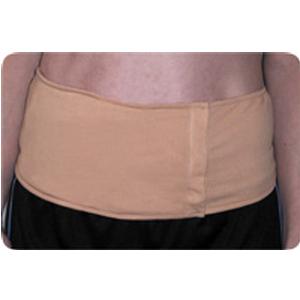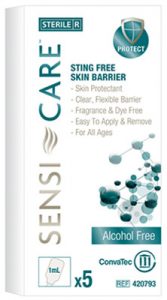Are you or someone you care for living with an ostomy and experiencing problems with the skin around the stoma? For those with an ostomy, peristomal skin damage is fairly common. However, it doesn’t have to become normal for you. First, you may want to identify the potential cause of the issue, which is an important part of figuring out how to treat your skin irritation. Next, consider taking several measures to avoid future damage to this sensitive area.
Causes Related to Peristomal Skin Damage
Incorrect Size or Shape of Skin Barrier
Getting the right skin barrier for your unique body may help reduce the risk of leakage and skin damage from stomal output. For example, skin folds or creases can make it difficult for the ostomy skin barrier to securely stick to the abdomen. An improper skin barrier fit can result in leakage, which may cause the skin to become irritated and begin breaking down. If your stoma is retracted or flush with your skin, you may want to consider a convex skin barrier.
ConvaTec’s SUR-FIT Natura Moldable Skin Barrier provides a personalized, custom fit around the stoma to help protect the peristomal skin. They are available in both flat and convex options.
 In addition to skin folds and stoma protection, the size of the stoma is an important factor in getting the right fit for your ostomy skin barrier. Ensuring that the barrier is the proper size may help prevent leakage. 1-2mm larger than the stoma is suggested for a close fit. The ConvaTec Natura Durahesive Accordion Trim-to-Fit Skin Barrier with Convexity features an easy cut-to-fit option for those needing a skin barrier with convexity and for use for those with a retracted stoma.
In addition to skin folds and stoma protection, the size of the stoma is an important factor in getting the right fit for your ostomy skin barrier. Ensuring that the barrier is the proper size may help prevent leakage. 1-2mm larger than the stoma is suggested for a close fit. The ConvaTec Natura Durahesive Accordion Trim-to-Fit Skin Barrier with Convexity features an easy cut-to-fit option for those needing a skin barrier with convexity and for use for those with a retracted stoma.
Frequent Applications and Removals
Continuous application and removal of skin barriers can really irritate the peristomal skin causing it to become extra-sensitive. The top layers of the skin can be stripped away, which can result in weepy, sore skin around your stoma. In order to address issues like this, ConvaTec created the Sensi-Care line of peristomal skin care products. These products work to protect skin from damage caused by adhesives and are great for using every day with no residue build-up or bonding to skin folds.
 Too Much Pressure Around the Stoma
Too Much Pressure Around the Stoma
When there is constant pressure at the stoma site, the skin may react unfavorably. Certain types of clothing or an ostomy belt that is too tight can irritate the peristomal skin by putting too much pressure on the site. Choosing the right ostomy appliance belt can provide an added sense of security when stabilizing an ostomy pouch. You want it to fit securely, of course, but make sure it is soft and comfortably adjusted as to not put too much pressure at the site.
Questions to Ask Yourself
Peristomal skin should look similar to the rest of the skin on the body. Slight redness in this area is normal due to the adhesive used on the barrier. However, any type of discomfort experienced could be a sign that the peristomal skin may be unhealthy. Asking yourself a few questions may help determine if there is more than meets the eye.
- Is the skin around your stoma itchy?
- Is the skin around your stoma blistered or inflamed?
- Does the skin around your stoma feel or appear as though it is wet?
Ask yourself these questions and then consult with your doctor or a WOCN (Wound, Ostomy, & Incontinence Nurse) about steps you can take to manage your peristomal skin issue.
Preventive Steps to Take
 By maintaining a good skin care routine, you can help prevent peristomal skin irritations from forming. These are some simple steps you can take:
By maintaining a good skin care routine, you can help prevent peristomal skin irritations from forming. These are some simple steps you can take:
- Routinely change your pouch.
- Use an adhesive remover to gently remove your skin barrier and any additional adhesive residues left behind.
- Use oil-free and alcohol-free products to reduce irritation when cleaning the skin around the stoma.
- Make sure your skin is completely dry before applying the next ostomy bag.
- Look closely at your peristomal skin each time you change out the barrier.
- Use a barrier foam or spray to protect the skin.
- Make sure the hole cut in the barrier is the correct size for your stoma.
- Ensure the barrier is secure with no gaps or folds to prevent leakage.
Peristomal skin should be healthy skin. Even the mildest irritation should be taken seriously and is worth getting advice from your doctor. Most of the time, solving the skin issue can be as simple as changing to a different product, altering your routine, or taking additional steps to rectify the problem.
For any questions about the products we carry or if you need help choosing the right barrier, belt, or bag, we are just a phone call away. Our Personally Delivered Product Experts will be happy to help you find exactly what you need.


